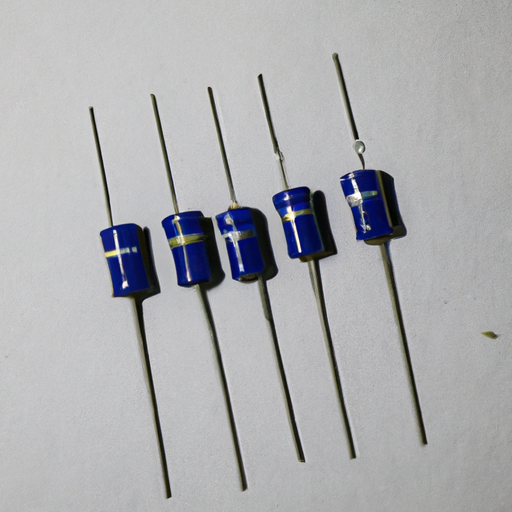CORE_COMPETENCE
Product_Leaders
index_more
index_more_content
info_item01
info_item_content01
info_item02
info_item_content02
info_item03
info_item_content03
info_item04
info_item_content04
NEWS
NEWS
application development in Capacitors for CFR-12JB-52-110R: key technologies and success stories
Application Development in Capacitors for CFR-12JB-52-110R: Key Technologies and Success Stories Application Development in Capacitors for CFR-12JB-52-110R: Key Technologies and Success Stories
While the CFR-12JB-52-110R is a resistor, the principles of application development for capacitors share many similarities. Capacitors are integral components in various electronic applications, and understanding their role, along with the technologies that facilitate their use, is essential for successful application development.
Key Technologies in Application Development for Capacitors Key Technologies in Application Development for Capacitors 1. Simulation Software 2. PCB Design Software 3. Embedded Systems 4. IoT Integration 5. Power Management ICs 6. Machine Learning and AI 1. Consumer Electronics 2. Electric Vehicles (EVs) 3. Renewable Energy Systems 4. Medical Devices 5. Telecommunications Success Stories Success Stories
Conclusion Conclusion
The development of applications involving capacitors, including those similar to the CFR-12JB-52-110R, requires a comprehensive understanding of simulation, design, and integration technologies. The success stories across various industries underscore the critical role capacitors play in enhancing performance, efficiency, and reliability in electronic devices. As technology continues to advance, capacitors will remain a cornerstone in driving innovation across multiple sectors, from consumer electronics to renewable energy and beyond.
2025-04-12
S6008L Resistors highlighting the core functional technology articles and application development cases of Resistors that are effective.
Overview of S6008L Resistors and Their Applications
The S6008L resistors are a specific type of resistor that can be utilized in various electronic applications. While detailed articles or case studies specifically on the S6008L may not be readily available, we can explore the core functional technology of resistors in general and highlight effective application development cases that demonstrate their utility.
Core Functional Technology of Resistors
1. **Basic Functionality**: Resistors are passive components that limit the flow of electric current in a circuit. They are essential for controlling voltage and current levels, ensuring that electronic devices operate within safe parameters.
2. **Types of Resistors**:
- **Fixed Resistors**: These resistors have a constant resistance value and are widely used in various applications.
- **Variable Resistors**: These include potentiometers and rheostats, allowing for adjustable resistance in circuits.
- **Specialty Resistors**: This category includes thermistors (temperature-sensitive), photoresistors (light-sensitive), and others designed for specific applications.
3. **Material Composition**: The performance of resistors is influenced by their material composition. Common materials include:
- **Carbon Composition**: Used for general-purpose resistors.
- **Metal Film**: Offers better stability and precision.
- **Wire-Wound**: Suitable for high-power applications.
4. **Power Rating**: Resistors are rated for the maximum power they can dissipate without overheating, typically measured in watts (W). This rating is crucial for ensuring reliability in circuit designs.
5. **Tolerance**: This indicates the allowable variation from the stated resistance value, expressed as a percentage. Lower tolerance values indicate higher precision, which is essential in sensitive applications.
6. **Temperature Coefficient**: This parameter measures how much the resistance changes with temperature, which is vital for applications requiring stable performance across varying environmental conditions.
Application Development Cases
1. **Voltage Divider Circuits**: Resistors are often used in voltage divider configurations to create reference voltages. For instance, in sensor applications, resistors can scale down voltage levels to match the input range of microcontrollers, ensuring accurate readings.
2. **Current Limiting in LED Circuits**: Resistors are crucial in LED circuits to limit the current flowing through the LED, preventing damage and ensuring optimal brightness. The selection of the appropriate resistor value is critical for achieving the desired current and brightness levels.
3. **Signal Conditioning**: In analog signal processing, resistors are integral to filters and amplifiers that shape and condition signals. For example, in audio applications, resistors can be part of low-pass or high-pass filters, controlling the frequency response and enhancing sound quality.
4. **Pull-Up and Pull-Down Resistors**: In digital circuits, pull-up and pull-down resistors are used to ensure that inputs to logic gates are at defined logic levels when no active devices are driving the inputs. This is essential for preventing floating inputs and ensuring reliable operation.
5. **Temperature Sensing with Thermistors**: Thermistors, a type of resistor, are widely used in temperature sensing applications. They change resistance with temperature, allowing for precise temperature measurements in HVAC systems, automotive applications, and consumer electronics.
6. **Power Management**: In power supply circuits, resistors are used for load balancing and creating voltage references. They play a crucial role in ensuring the stable operation of power management integrated circuits (ICs), which are essential for efficient energy use in electronic devices.
Conclusion
Resistors, including specific types like the S6008L, are fundamental components in electronic design, serving various roles from current limiting to signal conditioning. Their effectiveness in applications is largely determined by their specifications, including resistance value, power rating, and tolerance. Understanding these core technologies and their applications can lead to more efficient and reliable electronic designs. For specific articles or case studies, it is advisable to consult technical journals, manufacturer datasheets, or industry publications that focus on electronic components and circuit design. This will provide deeper insights into the practical applications and innovations involving resistors like the S6008L.
2025-04-12
What are the prices of popular variable resistor models in stock?
What are the Prices of Popular Variable Resistor Models in Stock?
I. Introduction
Variable resistors, commonly known as potentiometers, rheostats, or trimmers, are essential components in electronic circuits. They allow for the adjustment of resistance, enabling control over current flow and voltage levels. This functionality is crucial in various applications, from audio equipment to power control systems. In this article, we will explore popular variable resistor models, their specifications, and their price ranges, providing a comprehensive overview for anyone looking to purchase these components.
II. Understanding Variable Resistors
A. What is a Variable Resistor?
A variable resistor is an electronic component that allows the resistance to be adjusted manually or automatically. This adjustability is achieved through a movable contact that slides over a resistive element, changing the resistance value as it moves.
1. Definition and Functionality
Variable resistors are used to control electrical parameters in a circuit. By changing the resistance, they can adjust the current flow, voltage levels, and signal strength, making them versatile tools in electronic design.
2. Types of Variable Resistors
Potentiometers: These are the most common type of variable resistors, typically used for adjusting voltage levels in circuits. They have three terminals: two connected to the ends of a resistive element and one connected to a movable wiper.
Rheostats: Similar to potentiometers but usually used for higher power applications. They typically have two terminals and are used to control current in a circuit.
Trimmers: These are small potentiometers used for fine-tuning circuits. They are often adjusted only once during the setup of a device.
B. Applications of Variable Resistors
Variable resistors find applications in various fields, including:
1. Audio Equipment
In audio devices, potentiometers are used to control volume levels, tone adjustments, and balance settings. Their ability to provide smooth adjustments makes them ideal for these applications.
2. Power Control
Rheostats are commonly used in applications requiring power control, such as dimming lights or controlling motor speeds. They allow for precise adjustments to the power delivered to a load.
3. Signal Processing
In signal processing circuits, variable resistors help in adjusting signal levels, filtering, and tuning circuits to achieve desired performance characteristics.
III. Popular Variable Resistor Models
Several variable resistor models are widely recognized for their reliability and performance. Here, we will discuss some of the most popular models available in the market.
A. Overview of Popular Models
1. **Bourns 3386P Series**
2. **Vishay P1K Series**
3. **Alpha RV Series**
4. **Panasonic EVU Series**
5. **TE Connectivity 1-2150 Series**
IV. Price Analysis of Popular Models
A. Bourns 3386P Series
1. Specifications
The Bourns 3386P series is a multi-turn potentiometer known for its precision and reliability. It features a compact design, making it suitable for various applications, including audio and instrumentation.
2. Price Range
The price for the Bourns 3386P series typically ranges from $0.50 to $3.00 per unit, depending on the specifications and quantity purchased.
3. Availability
These potentiometers are widely available through online retailers and electronic component distributors.
B. Vishay P1K Series
1. Specifications
The Vishay P1K series is a high-quality potentiometer designed for general-purpose applications. It offers a linear taper and is available in various resistance values.
2. Price Range
Prices for the Vishay P1K series generally range from $0.75 to $2.50 per unit.
3. Availability
This series is readily available from major electronic component suppliers and online marketplaces.
C. Alpha RV Series
1. Specifications
The Alpha RV series is known for its robust construction and smooth operation. It is commonly used in audio applications and offers a variety of resistance values and shaft lengths.
2. Price Range
The price for the Alpha RV series typically ranges from $1.00 to $4.00 per unit.
3. Availability
These potentiometers can be found at various electronic retailers and online platforms.
D. Panasonic EVU Series
1. Specifications
The Panasonic EVU series features a compact design and is suitable for applications requiring space-saving components. It is known for its durability and performance.
2. Price Range
Prices for the Panasonic EVU series range from $0.80 to $3.50 per unit.
3. Availability
This series is available through numerous electronic distributors and online retailers.
E. TE Connectivity 1-2150 Series
1. Specifications
The TE Connectivity 1-2150 series is designed for high-performance applications, offering excellent linearity and stability. It is suitable for both commercial and industrial use.
2. Price Range
The price for the TE Connectivity 1-2150 series typically ranges from $1.50 to $5.00 per unit.
3. Availability
These variable resistors are available from various electronic component suppliers and online stores.
V. Factors Influencing Prices
Several factors can influence the pricing of variable resistors, including:
A. Material Quality
The materials used in the construction of variable resistors can significantly impact their performance and price. Higher-quality materials often lead to better durability and reliability.
B. Manufacturing Process
The complexity of the manufacturing process can also affect pricing. More intricate designs or specialized manufacturing techniques may result in higher costs.
C. Brand Reputation
Well-known brands with a reputation for quality often command higher prices. Customers may be willing to pay more for trusted brands due to perceived reliability.
D. Market Demand and Supply
Market dynamics, including demand and supply, can influence prices. High demand for specific models may lead to increased prices, while oversupply can drive prices down.
E. Technological Advancements
Advancements in technology can lead to the development of more efficient and cost-effective variable resistors, impacting their pricing in the market.
VI. Where to Buy Variable Resistors
A. Online Retailers
1. **Amazon**: A popular platform for purchasing electronic components, including variable resistors, often with competitive pricing and fast shipping.
2. **Digi-Key**: A leading distributor of electronic components, offering a wide selection of variable resistors with detailed specifications.
3. **Mouser Electronics**: Another reputable distributor that provides a vast inventory of electronic components, including various models of variable resistors.
B. Local Electronics Stores
Local electronics stores may carry a selection of variable resistors, allowing customers to inspect products before purchasing. However, availability may vary by location.
C. Wholesale Distributors
Wholesale distributors often provide bulk purchasing options at discounted prices, making them an excellent choice for businesses or individuals needing large quantities.
VII. Conclusion
In summary, variable resistors are vital components in electronic circuits, offering adjustable resistance for various applications. Understanding the different types and models available, along with their price ranges, can help consumers make informed purchasing decisions. As technology continues to advance, we can expect to see further innovations in variable resistor design and pricing, making them even more accessible and efficient for electronic applications.
VIII. References
- Manufacturer datasheets and specifications for variable resistor models.
- Online retailers and electronic component distributors for pricing and availability.
- Industry publications and articles on variable resistors and their applications.
By providing this comprehensive overview, we hope to equip readers with the knowledge needed to select the right variable resistor for their projects and understand the factors that influence pricing in the market.
2025-03-14

























